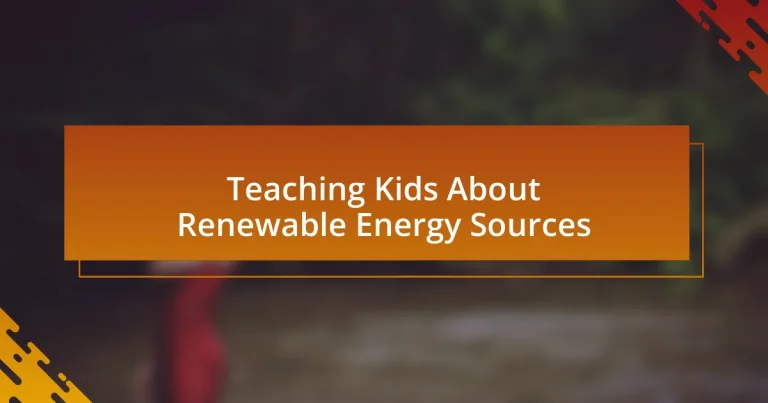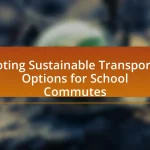The article focuses on teaching kids about renewable energy sources, emphasizing the importance of educating the younger generation on sustainable practices. It outlines various types of renewable energy, including solar, wind, hydroelectric, geothermal, and biomass, and highlights their environmental benefits compared to non-renewable sources. The article discusses effective teaching strategies, such as hands-on activities, interactive tools, and storytelling, to engage children and enhance their understanding of renewable energy concepts. Additionally, it addresses the long-term benefits of renewable energy, the role of early education in shaping future choices, and practical tips for parents and educators to reinforce these concepts at home and in the classroom.
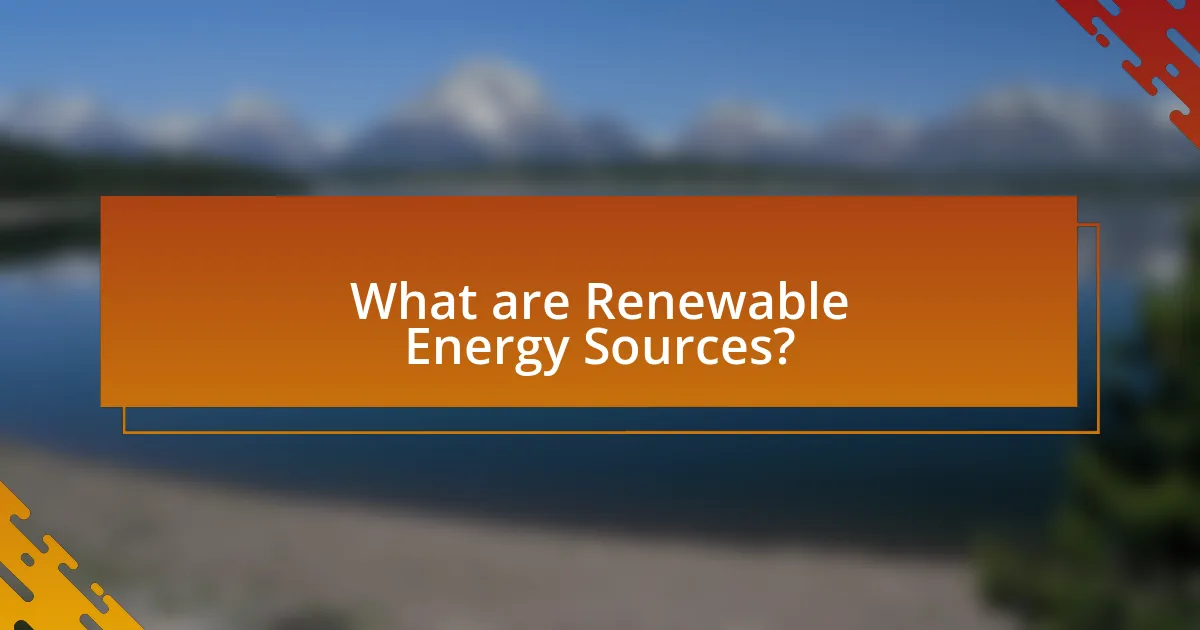
What are Renewable Energy Sources?
Renewable energy sources are energy resources that are naturally replenished and can be used continuously without depleting the Earth’s resources. These sources include solar energy, wind energy, hydroelectric power, geothermal energy, and biomass. According to the International Renewable Energy Agency (IRENA), renewable energy accounted for approximately 29% of global electricity generation in 2020, highlighting its growing importance in the energy landscape.
How do renewable energy sources differ from non-renewable sources?
Renewable energy sources differ from non-renewable sources primarily in their ability to regenerate naturally. Renewable sources, such as solar, wind, and hydroelectric power, can be replenished in a short time frame, while non-renewable sources, like coal, oil, and natural gas, are finite and take millions of years to form. For example, solar energy harnesses sunlight, which is abundant and continuously available, whereas fossil fuels are extracted from the Earth and will eventually deplete. This fundamental difference impacts sustainability, with renewable sources contributing to a lower carbon footprint and reduced environmental impact compared to the pollution and greenhouse gas emissions associated with non-renewable sources.
What are the main types of renewable energy sources?
The main types of renewable energy sources are solar energy, wind energy, hydroelectric energy, geothermal energy, and biomass energy. Solar energy harnesses sunlight through photovoltaic cells or solar thermal systems, making it a widely used source of clean energy. Wind energy captures the kinetic energy of wind using turbines, contributing significantly to electricity generation in many countries. Hydroelectric energy utilizes flowing water to generate power, often through dams, and is one of the oldest forms of renewable energy. Geothermal energy taps into the Earth’s internal heat for electricity and direct heating applications, showcasing its reliability. Biomass energy derives from organic materials, such as plant and animal waste, and can be converted into biofuels or used directly for heating. Each of these sources plays a crucial role in reducing greenhouse gas emissions and promoting sustainable energy practices.
Why is it important to transition to renewable energy?
Transitioning to renewable energy is crucial for mitigating climate change and reducing greenhouse gas emissions. Renewable energy sources, such as solar, wind, and hydroelectric power, produce little to no emissions during operation, which significantly lowers the carbon footprint compared to fossil fuels. According to the International Renewable Energy Agency, transitioning to renewables could reduce global CO2 emissions by up to 70% by 2050, helping to limit global warming to 1.5 degrees Celsius. This shift not only addresses environmental concerns but also promotes energy security and economic growth through job creation in the renewable sector.
What role do renewable energy sources play in sustainability?
Renewable energy sources are crucial for sustainability as they provide clean, inexhaustible energy that reduces greenhouse gas emissions and dependence on fossil fuels. By harnessing energy from natural processes such as sunlight, wind, and water, renewable sources contribute to a sustainable energy system that minimizes environmental impact. For instance, according to the International Renewable Energy Agency (IRENA), transitioning to renewable energy could reduce global carbon emissions by up to 70% by 2050. This significant reduction supports climate stability and promotes ecological balance, making renewable energy a fundamental component of sustainable development.
How do renewable energy sources contribute to reducing carbon footprints?
Renewable energy sources contribute to reducing carbon footprints by generating electricity without emitting greenhouse gases. For instance, solar panels convert sunlight into electricity, while wind turbines harness wind energy, both of which produce no direct carbon emissions during operation. According to the International Renewable Energy Agency, transitioning to renewable energy could reduce global carbon dioxide emissions by up to 70% by 2050. This significant reduction is crucial in combating climate change and promoting a sustainable future.
What are the long-term benefits of using renewable energy?
The long-term benefits of using renewable energy include reduced greenhouse gas emissions, enhanced energy security, and economic growth through job creation. Renewable energy sources, such as solar and wind, produce little to no emissions during operation, significantly lowering the carbon footprint and combating climate change. According to the International Renewable Energy Agency (IRENA), transitioning to renewable energy could create 24 million jobs globally by 2030, fostering economic development. Additionally, renewable energy reduces dependence on imported fuels, enhancing energy security and stability for nations.
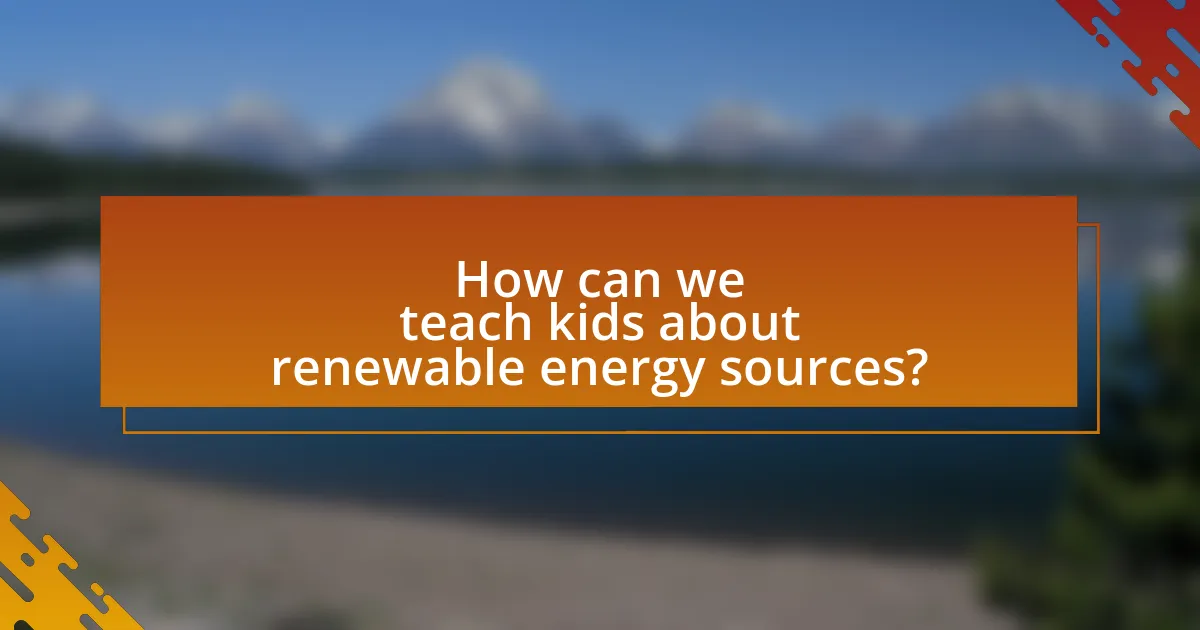
How can we teach kids about renewable energy sources?
To teach kids about renewable energy sources, educators can use interactive activities such as hands-on experiments, educational games, and field trips to renewable energy facilities. These methods engage children and help them understand concepts like solar, wind, and hydroelectric power. For instance, building a simple solar oven can demonstrate how solar energy works, while visiting a wind farm can provide real-world context. Research shows that experiential learning significantly enhances retention and understanding of scientific concepts, making these approaches effective in teaching about renewable energy.
What age-appropriate methods can be used to explain renewable energy?
Age-appropriate methods to explain renewable energy include interactive activities, visual aids, and storytelling. For younger children, hands-on experiments, such as building simple solar ovens or wind turbines, can illustrate how renewable energy works in a tangible way. Visual aids like diagrams and videos can help older children understand concepts like the energy cycle and the benefits of renewable sources. Storytelling can engage children by presenting relatable characters who use renewable energy in their daily lives, making the topic more accessible and interesting. These methods are effective because they cater to different learning styles and encourage active participation, which enhances understanding and retention of information about renewable energy.
How can hands-on activities enhance understanding of renewable energy?
Hands-on activities enhance understanding of renewable energy by providing experiential learning opportunities that engage students directly with the concepts. When students participate in building solar panels or wind turbines, they can see the principles of energy conversion and sustainability in action. Research indicates that experiential learning increases retention rates by up to 75%, compared to traditional lecture-based learning, which has a retention rate of about 5%. This active involvement allows students to grasp complex ideas, such as energy efficiency and environmental impact, more effectively than passive learning methods.
What resources are available for teaching kids about renewable energy?
Educational resources for teaching kids about renewable energy include interactive websites, hands-on activity kits, and educational books. Websites like National Geographic Kids and Energy.gov provide engaging articles and videos that explain renewable energy concepts in a kid-friendly manner. Activity kits, such as those from the Renewable Energy Education Program, offer practical experiments that allow children to build solar ovens or wind turbines, reinforcing theoretical knowledge through hands-on experience. Additionally, books like “The Kids’ Guide to Renewable Energy” by Jennifer Swanson provide age-appropriate explanations and illustrations, making complex topics accessible. These resources collectively enhance understanding and interest in renewable energy among children.
Why is it important to engage kids in renewable energy education?
Engaging kids in renewable energy education is crucial for fostering environmental awareness and promoting sustainable practices. By introducing children to concepts of renewable energy, they develop an understanding of the importance of sustainability and the impact of energy consumption on the planet. Research indicates that early education in renewable energy can lead to lifelong habits that prioritize environmental stewardship, as children who learn about these topics are more likely to advocate for and adopt sustainable practices in their daily lives. Furthermore, according to a study published in the journal “Environmental Education Research,” students exposed to renewable energy education demonstrate increased knowledge and positive attitudes towards energy conservation and renewable technologies.
How does early education about renewable energy influence future choices?
Early education about renewable energy significantly influences future choices by instilling awareness and understanding of sustainable practices from a young age. Children exposed to renewable energy concepts are more likely to adopt eco-friendly behaviors and support policies that promote sustainability as adults. Research indicates that early education fosters a sense of responsibility towards the environment, leading to informed decision-making regarding energy consumption and conservation. For instance, a study published in the Journal of Environmental Education found that students who participated in renewable energy programs demonstrated increased knowledge and positive attitudes towards renewable energy sources, which correlated with their future choices in energy use and advocacy.
What impact can kids have on promoting renewable energy in their communities?
Kids can significantly impact promoting renewable energy in their communities by raising awareness and influencing family and peer behaviors. Their enthusiasm for environmental issues often leads to initiatives such as school projects, community clean-up events, and advocacy for renewable energy policies. For instance, a study by the National Renewable Energy Laboratory found that children who participate in educational programs about renewable energy are more likely to encourage their families to adopt sustainable practices, such as using solar panels or reducing energy consumption. This ripple effect can lead to increased community engagement in renewable energy solutions, ultimately fostering a culture of sustainability.
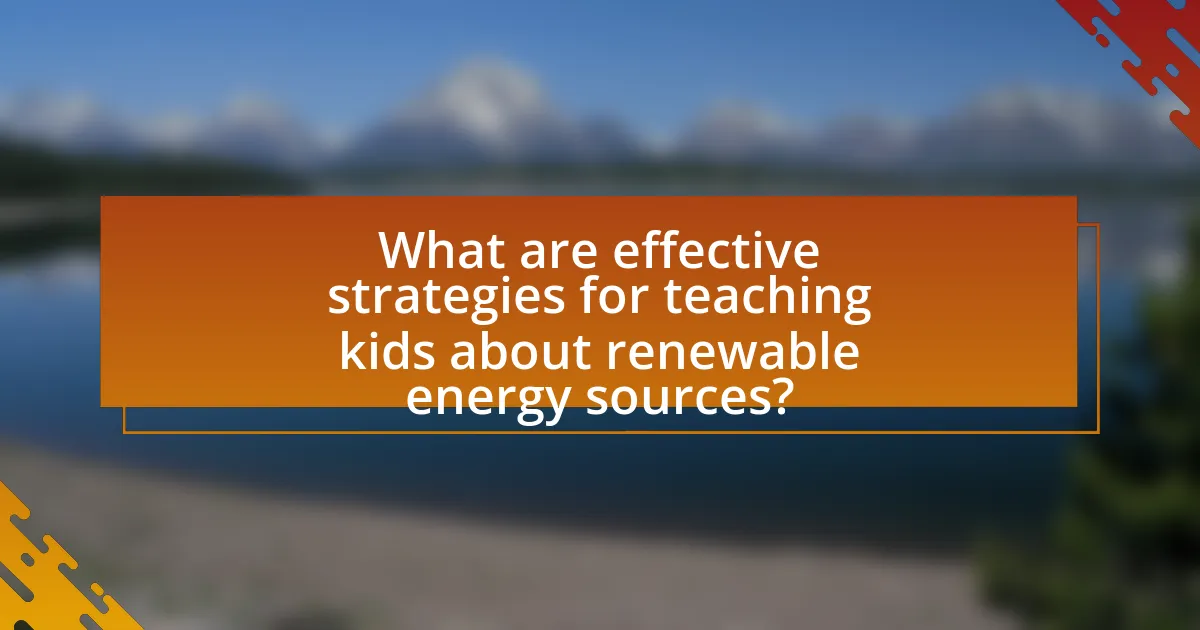
What are effective strategies for teaching kids about renewable energy sources?
Effective strategies for teaching kids about renewable energy sources include hands-on experiments, interactive games, and real-world applications. Engaging children in activities such as building solar ovens or wind turbines allows them to see renewable energy in action, fostering a deeper understanding of concepts. Additionally, using educational games that simulate energy production and consumption can make learning fun and memorable. Research shows that experiential learning significantly enhances retention and comprehension, as evidenced by studies indicating that students who participate in hands-on activities score higher on assessments related to energy concepts.
How can storytelling be used to explain renewable energy concepts?
Storytelling can be used to explain renewable energy concepts by creating relatable narratives that simplify complex ideas. For instance, stories can personify renewable energy sources, like wind or solar, allowing children to understand their functions and benefits through characters and adventures. Research shows that narratives enhance comprehension and retention of information, making it easier for kids to grasp abstract concepts. A study published in the Journal of Environmental Education found that storytelling significantly improved students’ understanding of environmental issues, including renewable energy, by engaging their emotions and imagination.
What are some examples of stories that illustrate renewable energy themes?
Examples of stories that illustrate renewable energy themes include “The Lorax” by Dr. Seuss, which emphasizes the importance of environmental stewardship and sustainable practices. Another example is “Energy Island” by Allan Drummond, which tells the story of how the Danish island of Samso transitioned to renewable energy sources, showcasing community involvement and innovation. Additionally, “The Boy Who Harnessed the Wind” by William Kamkwamba narrates the true story of a young boy in Malawi who builds a windmill to provide electricity for his village, highlighting the impact of renewable energy on improving lives. These stories effectively convey the significance of renewable energy through engaging narratives and relatable characters.
How can storytelling foster a deeper connection to renewable energy?
Storytelling can foster a deeper connection to renewable energy by making complex concepts relatable and engaging for audiences, particularly children. Through narratives that feature characters, challenges, and solutions related to renewable energy, children can visualize the impact of energy choices on their lives and the environment. For instance, stories about a young inventor who creates a solar-powered device can illustrate the benefits of solar energy in a tangible way. Research indicates that storytelling enhances retention and understanding, as it allows listeners to emotionally connect with the subject matter, making them more likely to embrace renewable energy practices in their own lives.
What interactive tools can be utilized in teaching renewable energy?
Interactive tools that can be utilized in teaching renewable energy include simulations, educational games, and interactive models. Simulations, such as those provided by platforms like PhET, allow students to experiment with renewable energy systems in a virtual environment, enhancing understanding through hands-on experience. Educational games, such as “Energy City,” engage students in decision-making processes related to energy use and sustainability, reinforcing concepts through play. Interactive models, like solar panel kits or wind turbine kits, enable students to build and test their own renewable energy devices, providing tangible learning experiences. These tools have been shown to improve student engagement and comprehension in science education, particularly in the context of renewable energy.
How can games and simulations help kids learn about renewable energy?
Games and simulations can effectively help kids learn about renewable energy by providing interactive and engaging experiences that illustrate complex concepts. These tools allow children to experiment with energy sources, such as solar, wind, and hydroelectric power, in a virtual environment where they can see the immediate effects of their decisions. For instance, a simulation might enable kids to design their own solar panel systems, helping them understand efficiency and energy output. Research shows that interactive learning methods, like those found in games, can enhance retention and understanding; a study by the University of Colorado found that students who engaged in simulation-based learning scored significantly higher on assessments related to energy concepts compared to traditional learning methods.
What online platforms offer educational resources on renewable energy?
Online platforms that offer educational resources on renewable energy include Coursera, edX, and Khan Academy. Coursera provides courses from universities like Stanford and Yale, focusing on various aspects of renewable energy, including solar and wind technologies. edX features programs from institutions such as MIT and Harvard, offering in-depth studies on sustainable energy systems. Khan Academy offers free resources and lessons aimed at younger audiences, simplifying complex concepts related to renewable energy. These platforms collectively provide a range of materials suitable for different age groups and educational levels, making them valuable for teaching kids about renewable energy sources.
What are some practical tips for parents and educators?
Parents and educators can effectively teach kids about renewable energy sources by incorporating hands-on activities, discussions, and real-world examples. Engaging children in projects like building simple solar ovens or wind turbines allows them to experience renewable energy concepts firsthand. Research shows that experiential learning enhances understanding and retention; for instance, a study by the National Science Foundation found that students who participated in hands-on science activities scored significantly higher on assessments than those who did not. Additionally, discussing current events related to renewable energy, such as advancements in solar technology or local sustainability initiatives, helps contextualize the information and makes it relevant to students’ lives.
How can parents reinforce renewable energy concepts at home?
Parents can reinforce renewable energy concepts at home by integrating practical activities and discussions into daily life. For example, they can install solar panels or energy-efficient appliances, demonstrating the benefits of renewable energy sources. Engaging children in projects like building a small wind turbine or starting a garden can illustrate how renewable resources work. Research shows that hands-on experiences significantly enhance understanding; a study by the National Renewable Energy Laboratory found that experiential learning increases retention of energy concepts by up to 80%. Additionally, parents can encourage conversations about energy consumption and sustainability, fostering a mindset that values renewable energy.
What activities can educators incorporate into their curriculum to teach renewable energy?
Educators can incorporate hands-on projects, such as building solar ovens or wind turbines, into their curriculum to teach renewable energy. These activities engage students in practical applications of renewable energy concepts, allowing them to experiment with energy conversion and efficiency. For instance, a study by the National Renewable Energy Laboratory found that students who participated in hands-on renewable energy projects demonstrated a 30% increase in understanding key concepts compared to traditional teaching methods. Additionally, incorporating simulations and interactive online resources can further enhance students’ comprehension of renewable energy systems and their real-world applications.
